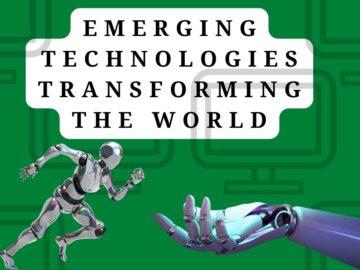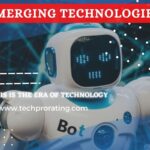Emerging technologies are rapidly transforming the world in various ways, from changing the way we live and work to revolutionizing industries and creating new ones. In recent years, we have seen a rapid acceleration in the development and deployment of new technologies. From artificial intelligence to the Internet of Things, these advancements are changing the way we live, work, and interact with each other. As a result, it’s crucial to understand how these technologies are shaping the future and how they will impact society as a whole. In this article, we’ll take a closer look at some of the most exciting and transformative emerging technologies that are shaping the future as we know it.
Artificial Intelligence (AI)
AI stands for artificial intelligence, which refers to the simulation of human intelligence in machines programmed to think and perform tasks like humans. AI technologies include machine learning, natural language processing, and computer vision, among others. AI is used in a wide range of applications, including speech recognition, image and video analysis, robotics, and autonomous vehicles. The goal of AI is to create intelligent machines that can learn, reason, and make decisions like humans, with the potential to solve complex problems and improve many aspects of human life. However, there are also concerns about AI’s ethical and societal implications, such as the impact on employment, privacy, and safety.
AI is transforming industries, such as healthcare, finance, and transportation, by enabling machines to perform tasks that typically require human intelligence. It is also transforming the way we interact with technology, with AI-powered virtual assistants and chatbots becoming more prevalent. Artificial Intelligence is one of the most exciting and rapidly growing areas of technology today. It involves the development of computer systems that can perform tasks without human intelligence, such as visual perception, speech recognition, and decision-making. With AI, machines can analyze vast amounts of data, identify patterns, and make predictions with a level of accuracy that was previously impossible. This is having a profound impact on a wide range of industries, from healthcare to finance, and is changing the way we work and live.
One of the most significant benefits of AI is that it can automate repetitive, low-level tasks, freeing up humans to focus on more creative and complex tasks. This is particularly valuable in fields such as healthcare, where AI systems can help doctors diagnose diseases and recommend treatments. AI can also be used to analyze vast amounts of data, such as patient records, to identify patterns and make predictions about disease outbreaks and patient outcomes.
Another exciting area of AI is the development of autonomous systems, such as self-driving cars. These systems use advanced sensors and machine learning algorithms to perceive their environment and make decisions in real time. This has the potential to revolutionize transportation and make our roads safer, more efficient, and more accessible for everyone.
The Internet of Things (IoT)
IoT stands for the Internet of Things, which is a system of interrelated physical devices, vehicles, home appliances, and other items embedded with sensors, software, and connectivity, enabling them to collect and exchange data over the internet. IoT devices can range from smart thermostats and security cameras to wearable fitness trackers and industrial machinery. The data collected by these devices can be analyzed to provide insights, improve efficiency, and optimize performance. IoT has the potential to transform many industries, including healthcare, transportation, agriculture, and manufacturing. However, there are also concerns about the security and privacy risks associated with IoT devices, as well as the potential for job displacement and the need for new skills to manage and maintain these systems.
The IoT refers to the connection of physical devices and objects to the internet, allowing for the collection and sharing of data. This technology is transforming industries such as agriculture, healthcare, and manufacturing, by improving efficiency and reducing costs. The Internet of Things (IoT) refers to the network of devices, vehicles, and other physical objects that are connected to the internet and equipped with sensors and software to collect and exchange data. With the rapid expansion of IoT, we are seeing a world where everyday objects are becoming more intelligent and more connected, allowing them to interact with each other and with us in new and innovative ways.
One of the most significant benefits of IoT is the ability to collect and analyze vast amounts of data in real time. This allows us to make more informed decisions, optimize our processes, and improve our overall quality of life. For example, IoT devices can be used to monitor and control the energy consumption of buildings, reducing waste and saving money.
Another exciting area of IoT is the development of smart cities, where networks of sensors and other technologies are used to monitor and manage various aspects of urban life, from traffic flow to air quality. By analyzing data from these sensors in real time, city planners can make more informed decisions about how to allocate resources, manage traffic, and improve the quality of life for residents.
Virtual and Augmented Reality (VR/AR)
VR stands for Virtual Reality and AR stands for Augmented Reality. Virtual Reality is a technology that allows users to enter a computer-generated 3D environment and interact with it as if it were the real world. VR typically involves using a headset or a display device that covers the user’s eyes, along with motion sensors and input devices such as controllers or gloves, to create an immersive experience. VR is commonly used in gaming, training simulations, and educational applications, among other things.
Augmented Reality, on the other hand, is a technology that overlays digital information onto the real world, usually through a camera-enabled device such as a smartphone or a tablet. AR enhances the user’s perception of the real world by adding virtual elements such as images, sounds, or text. AR is commonly used in advertising, gaming, and educational applications, among others.
Both VR and AR have the potential to revolutionize many industries, including entertainment, education, healthcare, and retail. However, there are also concerns about the potential negative effects of prolonged use, such as motion sickness or eye strain, and the need for standards and regulations to ensure user safety and privacy.
AR and VR technologies are transforming the way we experience the world around us, from entertainment and gaming to education and training. They are also transforming industries such as architecture and design, by allowing for immersive virtual experiences. Virtual Reality (VR) and Augmented Reality (AR) are technologies that will enable us to experience digital content in a more immersive way. VR systems, such as the Oculus Quest, allow us to enter virtual worlds and interact with digital objects as if they were real. AR systems, such as the Microsoft HoloLens, superimpose digital information on the real world, allowing us to see the physical world with added layers of information.
One of the most significant benefits of VR and AR is the ability to provide more immersive and engaging experiences. For example, in the field of education, VR and AR systems can be used to create interactive learning experiences that allow students to explore new concepts.
Quantum Computing
Quantum computing is an emerging field of computer science that aims to harness the principles of quantum mechanics to perform complex calculations faster and more efficiently than classical computers. Quantum computers use quantum bits, or qubits, which can exist in multiple states simultaneously, allowing them to perform many calculations at once. This makes quantum computers particularly well-suited for certain types of problems, such as optimization, cryptography, and simulation.
Quantum computing has the potential to revolutionize many fields, including drug discovery, finance, and climate modeling. For example, quantum computing could be used to develop new drugs more quickly and accurately by simulating the behavior of molecules in a way that classical computers cannot. It could also be used to optimize financial portfolios, improve weather forecasting, and enhance artificial intelligence algorithms.
However, quantum computing is still in the early stages of development and faces many challenges, including the need to develop reliable qubits, the ability to control and manipulate them, and the development of new algorithms and software that can take advantage of quantum computing capabilities. Additionally, there are concerns about the potential impact of quantum computing on cybersecurity and encryption, as some existing encryption methods may be vulnerable to attack by quantum computers. Quantum computing technology uses quantum mechanics to do impossible calculations for classical computers. It is transforming industries such as finance, logistics, and drug discovery, by enabling faster and more efficient calculations.











